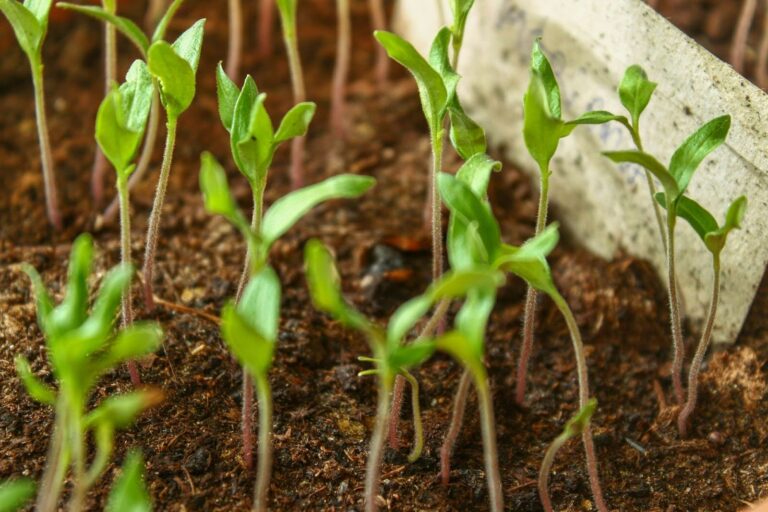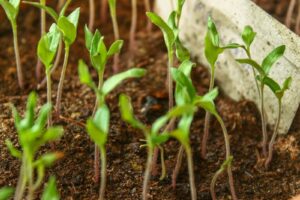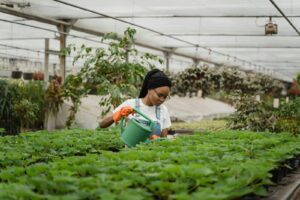Is your garden stuck at the seedling stage? You carefully plant your seeds, water them just right, and wait for them to spring to life. You’ve done everything by the book, but your seedlings look like they’ve hit pause. They’re not thriving, just barely surviving. Slender stems, faded color, hardly any growth.
And every morning you check them, hoping for progress that just isn’t there. That nagging feeling creeps in. Did you mess something up? Is the soil bad? Are your lights too bright or not bright enough? Most of the time, the issue isn’t your skills. It’s the conditions your seedlings are trying to grow in.
Slow seedling growth happens to even the most experienced growers. But it’s not a dead end. With the right understanding and a few adjustments, you can get your seedlings back on track.
This article explores why seedlings slow down, how environmental stress plays a huge role, and what steps you can take to support healthier, faster growth. We’ll look at temperature, lighting, humidity, soil issues, nutrient deficiencies, pest problems, and root health. You’ll also get practical ways to fix these problems and simple tips to build stronger, more resilient seedlings. Let’s dig in.
Understanding Slow Seedling Growth
Seedlings are delicate. In their early stages, they rely entirely on the environment you create for them. Before you can fix the problem, you must know what kind of pressure your seedlings face.
Environmental conditions play a massive role here. Think of seedlings as sensitive indicators. They don’t just grow, they respond.
When seedlings are stressed, their energy goes into survival, not growth. That’s why spotting and fixing these conditions early gives them a better chance to thrive.
Now, let us understand the common causes of slow cannabis seedling growth.
Common Causes of Slow Seedling Growth
Once you understand how environmental stress impacts seedling development, it’s time to pinpoint the causes that occur most often in gardens and grow rooms.
Let us break down the most frequent triggers for slow growth:
- Temperature fluctuations affecting growth: Seedlings hate surprises. One chilly night or a sudden heat wave can stunt their development. If temperatures shift too much between day and night, growth slows down dramatically. Consistency is key. Most seedlings thrive in a stable temperature range, so monitor it closely and make adjustments when needed.
Tip: Tools like PlanaCan help maintain this consistency by generating detailed reports for each harvest, capturing data on cultivation decisions and their impact on yield. With everything organized in one place, it’s easier to spot trends, refine methods, avoid repeat mistakes, and ultimately boost yields and profitability.
- Impact of improper lighting conditions: Insufficient or excessive light is a dealbreaker. Too little, and your seedlings stretch out weak and leggy. Too much, and they burn. Your goal should be to give them intense, indirect light for 12 to 16 hours a day.
- Role of humidity in seedling development: Humidity helps seedlings absorb water and nutrients, but too much or too little humidity can throw off that balance. Low humidity leads to dehydration, and high humidity invites fungus and disease.
- Effects of overwatering and underwatering: Watering is tricky. Overwatered seedlings rot, and underwatered ones shrivel. The key is to keep the soil moist, not soaked. Touch the topsoil with your finger. If it feels dry about an inch deep, it’s time to water. If it’s still damp, wait.
Now, let us understand soil and nutrient challenges that might lead to slow cannabis seedling growth.
Soil and Nutrient Related Challenges
As you grow cannabis seedlings, you might face several soil and nutrient-related challenges impacting their growth. Here are some key points to consider and watch out for:
- Poor Soil Drainage: If your soil doesn’t drain well, it can cause waterlogged conditions that stunt the root development of your seedlings. Choose soil with good aeration or amend it with perlite or other drainage-enhancing materials.
- Nutrient Imbalance: Seedlings are delicate, and too much or too little of specific nutrients can harm them. A nitrogen excess might cause leggy growth, while deficiencies in phosphorus and potassium can lead to poor root development and weak stems.
- pH Imbalance: Cannabis seedlings thrive in soil with a pH between 6.0 and 7.0. If the pH is too high or too low, it can lock out essential nutrients, making them unavailable to the plant.
- Overfeeding or Underfeeding: Overfeeding with fertilizers can cause nutrient burn, leading to yellowing leaves and stunted growth. On the flip side, underfeeding can result in slow or weak growth. Start with a light feeding schedule and monitor how the seedlings react.
Tools like PlanaCan help generate detailed reports for each harvest, tracking cultivation decisions and their impact on yield. With all data in one place, it’s easier to spot trends. Reviewing these insights lets you identify what works, avoid mistakes, and refine your nutrient strategy for better yields and healthier plants.
- Inconsistent Moisture Levels: Seedlings require consistent moisture. Too much water can drown them, while too little can dry them out. Keep the soil moist but not soaking, ensuring it has proper drainage to maintain a steady water supply.
- Contaminated Soil: Soil can sometimes carry pests, diseases, or pathogens that harm your seedlings. Make sure to use clean, high-quality soil and avoid using soil from unreliable sources.
- Compacted Soil: Compacted soil restricts root growth and can suffocate seedlings. Ensure the soil is loose enough to allow the roots to expand and access oxygen.
Diseases and pests are often silent threats that show up when you least expect them. And once they do, the damage can spread quickly. Let us discuss their impact there in detail.
Disease and Pest Impacts
Several diseases and pests can hinder their development, leading to stunted growth, reduced yields, or even plant death. Here’s how different factors affect cannabis seedling growth and what you can do about them.
Diseases Affecting Cannabis Seedlings
- Root Rot (Pythium and Phytophthora): Root rot is a fungal disease caused by pathogens like Pythium and Phytophthora. These pathogens thrive in overly moist, poorly draining soil. If your seedlings show yellowing leaves, stunted growth, and a foul smell from the soil, root rot could be the culprit.
What you can do: Ensure proper drainage in your growing medium, avoid overwatering, and consider using disease-resistant strains or fungicides.
- Damping-Off (Various Fungi): Damping-off is a fungal disease that causes seedlings to collapse at the base, often appearing to wilt and die quickly. It thrives in damp, poorly ventilated environments.
What you can do: Improve air circulation, avoid excessive watering, and keep the growing environment clean. Sterilize tools and containers before use.
- Powdery Mildew: Powdery mildew can affect seedlings by coating their leaves with a white, powdery substance. This inhibits photosynthesis, weakening the plant and stunting growth.
What you can do: Increase airflow around your plants and avoid high humidity. If necessary, apply organic fungicides.
- Bacterial Wilt (Ralstonia solanacearum): This bacterial infection causes sudden wilting in seedlings, typically leading to rapid death. It spreads through contaminated soil and water.
What you can do: Practice crop rotation, sterilize tools, and avoid using infected water or soil. If detected early, removal of affected seedlings can help prevent spreading.
- Gray Mold (Botrytis cinerea): Gray mold is a fungal infection that thrives in humid, cool conditions. It often attacks damaged plant tissues and can spread quickly if conditions remain favorable.
What you can do: Keep humidity levels in check and ensure seedlings are not overcrowded. Prune any affected plant tissue and remove it immediately.
Pests Impacting Cannabis Seedling Growth
- Aphids: Aphids are small insects that feed on plant sap, weakening seedlings. They can spread viruses and leave behind sticky residue, which attracts mold.
What you can do: Regularly inspect your plants for aphids and use insecticidal soap or natural predators like ladybugs.
- Fungus Gnats: Fungus gnats are attracted to damp soil and can damage the roots of seedlings. Their larvae feed on root systems, leading to stunted growth.
What you can do: Avoid overwatering, allow the soil to dry between waterings, and use yellow sticky traps to reduce the adult population.
- Spider Mites: Spider mites are tiny pests that can cause leaves to become speckled and yellow. These pests thrive in hot, dry conditions and can quickly overwhelm seedlings.
What you can do: Increase humidity to make the environment less hospitable for mites, and consider using predatory mites or neem oil to control the infestation.
- Thrips: Thrips are small, slender insects that feed on plant cells, leading to silver streaks or spots on the leaves. In large numbers, they can severely stunt seedling growth.
What you can do: Regularly inspect for thrips, particularly on the underside of leaves. Use predatory insects like predatory mites or apply insecticidal soap to reduce populations.
- Whiteflies: Whiteflies are tiny, flying pests that feed on plant sap, causing yellowing leaves and potentially transmitting viruses.
What you can do: Introduce natural predators, like lacewing larvae, or apply insecticidal soap and neem oil to keep their numbers in check.
- Slugs and Snails: Slugs and snails can feast on cannabis seedlings, particularly during their early growth stages. They create holes in leaves and stems, which can lead to infection.
What you can do: Use copper barriers, beer traps, or natural slug repellents to prevent damage.
So, why is root system development important for the healthy growth of seedlings? Let us understand.
Importance of Root System Development
A healthy and well-developed root system is the engine behind your plant’s growth. Here’s why root development should be a top priority in your grow setup:
- Efficient Water and Nutrient Absorption: Robust roots absorb moisture and nutrients more effectively, fueling faster and more balanced growth.
- Stronger Physical Support: A widespread, stable root system anchors the plant and helps prevent wilting or collapse.
- Enhanced Resistance to Stress: Plants with well-developed roots bounce back faster from environmental stressors like heat, drought, or nutrient imbalances.
- Improved Microbial Interactions: Healthy roots engage with beneficial microbes in the soil, which can improve nutrient availability and protect against pathogens.
- Better Oxygen Intake: Well-aerated root zones allow roots to access the oxygen they need for cellular respiration, supporting overall vigor and energy production.
- Faster Recovery After Transplanting: Strong roots adapt more easily when moved to a new container or outdoor bed, reducing transplant shock and promoting quicker recovery.
- Greater Yield Potential: Ultimately, plants with a robust root system can support more foliage, more flowers, and heavier harvests due to better access to all the essentials they need to grow.
Now, let us understand ways to combat slow seedling growth and ensure their proper development.
Ways to Combat Slow Cannabis Seedling Growth
If you’ve noticed your cannabis seedlings are growing slowly, there are a few things you can do to help speed up the process and encourage healthier development. Here are some practical tips:
- Ensure Proper Lighting: Ensure your seedlings get the right amount of light. If you’re growing indoors, use grow lights with the correct spectrum for seedlings (usually blue light). Place the lights close to the plants but not too close to avoid burning them. If growing outdoors, ensure your plants are in a spot that gets enough sunlight each day.
- Maintain Optimal Temperature: Seedlings thrive in a consistent temperature range, ideally between 70- 85°F (21- 29°C). If the temperature is too low, their growth may slow down. Keep the area warm, especially at night. To keep things warm, especially at night, use what you already have; adjust thermostats, run climate controls, or place heat mats under seedlings.
- Check Humidity Levels: Seedlings need a humid environment to grow properly. Aim for around 60–70% humidity. If it’s too dry, consider using a humidity dome or a small humidifier to create a more favorable environment.
- Water Properly: Overwatering can stunt seedling growth, so make sure the soil has proper drainage. Water gently and only when the top of the soil feels dry to the touch. Let the roots breathe and avoid waterlogging.
- Use the Right Soil: Ensure your seedlings are planted in light, well-draining soil that’s rich in nutrients. A mix designed for seedlings or young plants works best, allowing proper root development.
- Avoid Overfeeding: While your seedlings will need nutrients, they are sensitive to too much fertilizer. Too much nitrogen can burn them or stunt growth. Start with a mild fertilizer and only apply it when necessary.
- Ensure Good Air Circulation: Air circulation is key for strong, healthy seedlings. Without it, your plants may become weak and susceptible to disease. A small fan in your grow space can improve airflow and prevent issues like mold.
- Transplant When Necessary: If your seedlings outgrow their containers before they go outside or into a larger pot, don’t hesitate to transplant them into bigger containers. Root-bound seedlings struggle to grow properly.
- Avoid Stress: Seedlings are delicate, so minimize any stress during their early stages of growth. Avoid unnecessary handling, sudden temperature changes, or environmental stressors that could slow their growth.
Conclusion
Struggling seedlings can test your patience, but they also teach you how to become a better grower. The effort you put in now leads to healthier, more productive plants later. Every adjustment and every tweak builds your experience. Keep at it, stay curious, and soon enough, your seedlings will not just survive, they’ll thrive.
And as your skills improve, the right tools can make all the difference. PlanaCan helps cannabis growers maximize their yields and take complete control of their crops with precision and ease. It simplifies cultivation by letting you create customized templates for every strain and grow cycle. You can plan each step, from planting to harvest, and schedule tasks onto a calendar in just a few clicks, ensuring a streamlined, consistent workflow every time.
It also offers a clear visual timeline that helps you organize months ahead and manage daily tasks without missing a beat. Adjust on the fly, stay aligned with your team, and keep every detail under control.
Take your growth to the next level. Schedule a free call today and see how PlanaCan can support your success.




